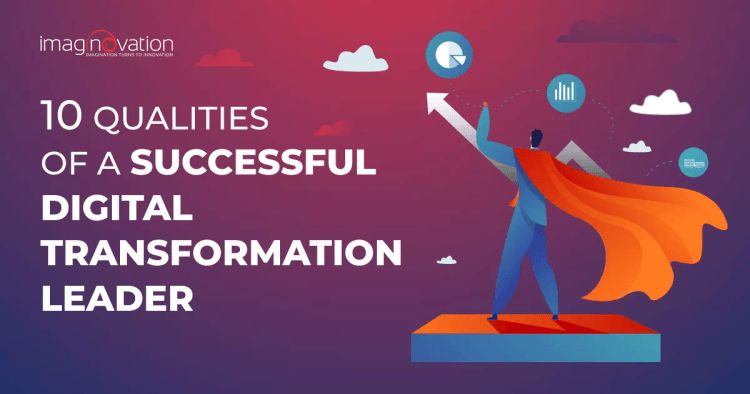When it comes to digital transformation (DX), qualified and effective leadership can fast-track business success.
The role of the transformation leader has evolved significantly in recent years. From selecting the right digital tech stack to facilitating the rollout of new systems, a transformation leader must address various challenges in digitization.
Oftentimes, they find it challenging to guide the organization through a digital revolution. It requires a new set of leadership traits to tackle modern business challenges and make a long-lasting impact. Therefore, in this blog, we will discuss the top 10 qualities of a successful digital transformation leader.
Let’s start!
The Role of Future Leaders in Digital Transformation
With digital transformation on the rise, companies are experiencing a shift in responsibilities across different roles. The role of the transformation leader is filled with challenges and learning curves.
Traditionally, CIOs and CTOs are in charge of a company’s IT (information technology) modernization. However, their roles have now become much more focused on leading business strategies for the digital age.

Today, these C-suite leaders are not only responsible for the company’s overall IT strategy but also for:
- Establishing objectives for digital transformation initiatives
- Analyzing the costs and potential value of technology
- Designing company-wide digital transformation strategies
- Managing key players in the digital transformation process
- Motivating and aligning team members to embrace transformational initiatives and technologies
- Building a culture that supports innovation and technology-driven initiatives
So, what new qualities should CTOs and CIOs possess to successfully lead DX initiatives? What characteristics help a CIO or CTO drive impactful transformation?
Let’s see.
1. Think Customers First
A successful transformation leader always thinks of customers first.
Customer expectations are rising daily, and therefore, excellence in a single channel is no longer sufficient for your business. Customers expect the same frictionless and smooth experience in a physical store as they do when shopping online, and vice versa. They have become less tolerant of poor experiences.
Improving customer experience should be at the core of your digital transformation strategy. You can gather actionable data from every customer interaction and use this data to test your assumptions about how customers use digital platforms and how you can further fine-tune their experiences.
EY’s Global Microsoft Alliance Lead and America’s Technology Strategy Lead, Jim P. Little, says, “There’s a real focus on having much more of an experience mindset. It’s really about thinking through the customer experience and then applying your digital technologies against that.”
2. Recognize the Urgency
Tim O’Reilly, Founder and CEO of O’Reilly Media, said, “Every industry and every organization will have to transform itself in the next few years. What is coming at us is bigger than the original internet, and you need to understand it, get on board with it, and figure out how to transform your business.”
Implementing digital transformation in a business involves reimagining how the organization functions—from its processes and systems to its data, customer experiences, and people.
Although the need for change is nothing new, the challenges of the year 2020 have heightened the sense of urgency.
Today, businesses do not have the luxury of ample time. Therefore, you need to recognize the urgency and respond with a clear strategy and strong vision.
3. Embrace New Technology
When deployed at the right time and place, new technologies can drive impactful transformation. But there’s a catch.
Leaders must keep their goals in focus and not get distracted by the latest shiny technologies that everyone seems to be using.
Jeff Immelt, former CEO of GE, at an IT conference, said, “IT leaders, CIOs specifically, need to stop being so passive. I view IT’s role, the role of the CIO, as being frankly one of the most important, if not the most important, roles at the leadership table today. Because company CIOs that can’t understand how to use technology to change their business models are going to find themselves somewhat out of jobs.”
Whether you are tempted to use IoT, blockchain, or AI, understanding how any specific technology contributes to your transformational initiative is crucial.
Remember, adopting new technology to meet particular business needs and integrating it with existing systems can sometimes be a complex endeavor. So, make sure to partner with those who have the technological know-how.
4. Be Data-Driven
Data is the new gold, especially when it comes to transforming businesses digitally.
Data helps you make smarter decisions. Collecting, processing, and analyzing data is an integral part of the DX process.
Data is generated in various forms, structured and unstructured. Therefore, you need to choose the right technologies to process large amounts of unstructured data. This also involves discarding enormous quantities of data that may never have been used and never will be used.
“Less than 1% of data in businesses is analyzed and transformed into benefits.” — SAP
The role of DX leaders includes actively seeking all types of data from all business areas to create a unified database containing a single version of the truth, accessible to everyone. They then use it to drive personalized customer and team interactions.
For example, US Xpress, a US transportation firm, gathers real-time data from multiple sources, including in-vehicle sensors and geospatial systems. It uses Apache Hadoop, an open-source tool for data analysis, and other business intelligence tools.
The company has been able to extract valuable insights about its operations. In the first year of transformation, the company saved more than $20 million in fuel consumption due to idling.
5. Challenge Core Beliefs
Jeff Bezos (Amazon Founder) said, “In today’s era of volatility, there is no other way but to reinvent. The only sustainable advantage you can have over others is agility; that’s it. Because nothing else is sustainable; everything else you create, somebody else will replicate.”
As a CIO or CTO of your company, examine whether you have deeply ingrained core beliefs about your organization.
Such core beliefs can create blind spots.
So what needs to be done?
Challenge these beliefs to ensure they are still relevant in the current business scenario. Determine how and when the new belief will work and check this against your competitors’ actions. Analyze which core beliefs should be altered or even discarded.
Failing to do this risks maintaining the status quo, which can hinder your organization’s progress.
Continue challenging the status quo rather than accepting old, historical norms. Examine how everything is done—the products and services you offer and the market segments you cater to—and seek answers to “Why?”
Examine all aspects of your business in detail—both customer-facing and back-office processes—for digitally driven innovation.
6. Empower the Workforce
Digital transformation is not only about modernizing your business platforms but also about digitally empowering your workforce.
You don’t need to be overly obsessed with new technology. Instead, accept that change begins with people. Encourage your coworkers to ask questions, develop innovative solutions or ideas, and challenge decisions.
Transformation leaders should be willing to lead and facilitate change not only among the teams but within themselves as well.
“You cannot delegate digital transformation for your company… You and your executives have to own it! Executives need to engage, embrace, and adopt new ways of working with the latest and emerging technologies.” — Barry Ross, CEO & Co-Founder, Ross & Ross International.
7. Break Down the Silos
Silo mentality creates problems. Teams are often unwilling to share information with colleagues from different departments, resulting in low team morale and adversely affecting the company’s workflow.
As a DX leader, you can play a crucial role in bringing teams together. Market disruption is no time for fostering friction between teams, even if it’s called “friendly rivalry.” You need to work actively to transform the silo mindset in the company by creating shared objectives and accountabilities.
You can develop tools to facilitate and sustain cross-departmental cooperation and encourage and reward behaviors that promote teamwork and collaboration.
8. Adopt a Beginner’s Mindset
Implementing transformation is best achieved by a leader with a ‘beginner’s mindset.’ Essentially, someone who does not believe they have all the answers, but who has the self-confidence to experiment and support activities with unknown outcomes.
Someone who faces challenges and opportunities with an open mind and is ready to learn as well as unlearn.
A ‘beginner’s mindset’ involves challenging assumptions, dropping judgment, and encouraging curiosity.
The business world continues to face challenges that need solutions. These challenges provide opportunities for you to learn and grow. Remember, you have to continue challenging the status quo. Do not be afraid to fall or fail. Do not shy away from new ways of doing things or exploring uncharted territories.
9. Develop a Long-Term Vision
A successful transformation leader should also have a clear vision of where they want to be in the long term.
Digital transformation is not a one-time process but an ongoing journey. You need to have the foresight to develop and pursue a long-term vision while implementing short-term objectives to achieve incremental progress.
As Albert Einstein said, “The measure of intelligence is the ability to change.”
Develop a roadmap for digital transformation that outlines your vision for the next 3 to 5 years. Continuously assess and adjust your strategy based on emerging trends and changing market conditions.
10. Lead with Empathy
Empathy is a critical quality of effective leadership.
As a digital transformation leader, you must understand and relate to your team’s emotions, thoughts, and perspectives. Your approach should address their concerns, offer support, and inspire them to embrace change.
Empathy helps you to build trust and foster a positive work environment, which is essential for successful digital transformation.
“People will forget what you said, people will forget what you did, but people will never forget how you made them feel.” — Maya Angelou.
Final Thoughts
The journey of digital transformation is complex and multi-faceted. The role of a transformation leader is equally challenging but crucial in guiding the organization through this process.
To succeed, a transformation leader must embody these ten qualities: thinking of customers first, recognizing urgency, embracing new technology, being data-driven, challenging core beliefs, empowering the workforce, breaking down silos, adopting a beginner’s mindset, developing a long-term vision, and leading with empathy.
Embracing these qualities can help CIOs and CTOs drive impactful transformation and lead their organizations to new heights of success.
Feel free to share your thoughts and experiences on the qualities of a successful digital transformation leader in the comments below!
Ready to build an app, but not sure where to start?
We've got you covered. Click the button below to get started.





